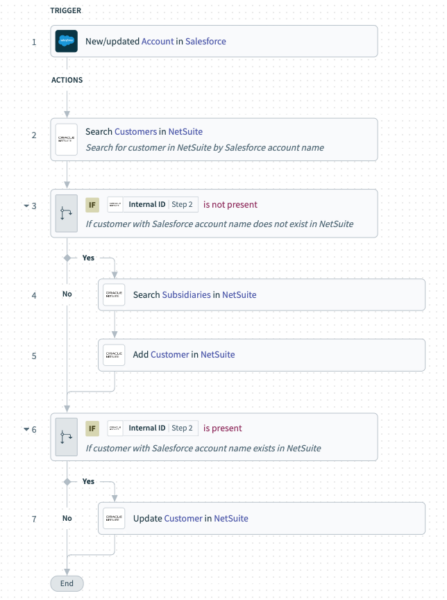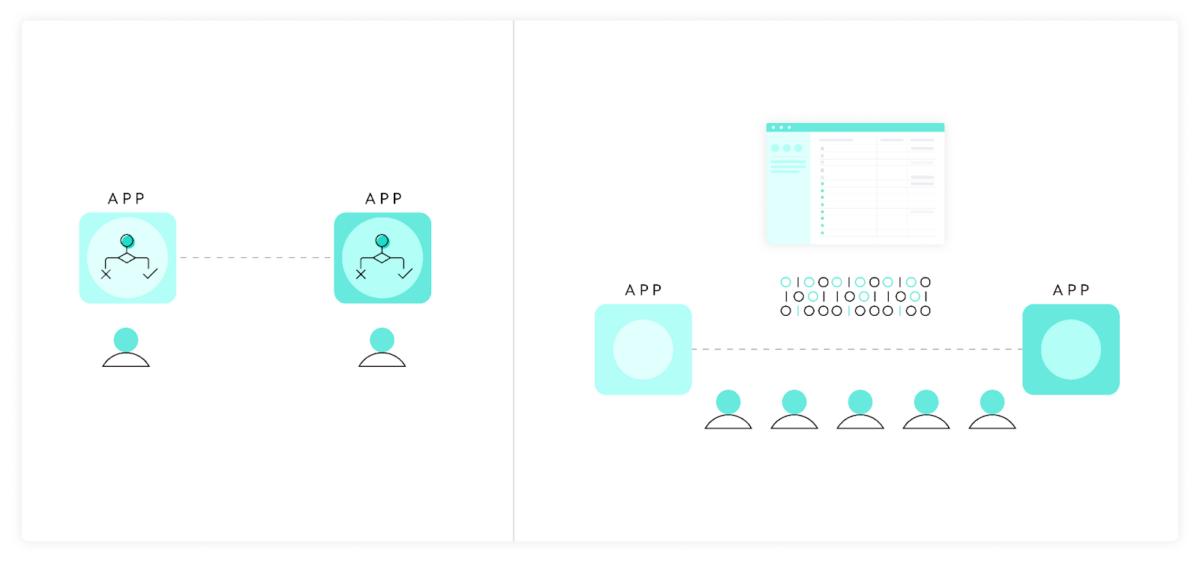The benefits of implementing API integrations is wide-ranging—from allowing you to move data in near real-time to enabling your team to build end-to-end automations. As a result, the question isn’t whether you should implement them—it’s how you go about doing so.
To help you build API integrations successfully, we’ll offer several crucial tips. But to start, let’s align on the definition of API integration.
What is API integration?
It’s the use of an in-house or 3rd-party solution to connect your applications and databases via their APIs. Once connected, data can move freely between the systems, all but ensuring that your employees and partners can access the data they need within the platforms they rely on.
To help make this definition more tangible, let’s use an API integration example:
Let’s say that you decide to connect your CRM (e.g. Salesforce) with your ERP system (e.g. NetSuite) via their APIs so that any time an opportunity closes in the former, it’s added to the latter automatically.
Here’s how you can build the integration:

1. Once a sales rep updates an account in your CRM as “Closed Won”, the workflow gets triggered.
2. If the account doesn’t exist as a client in your ERP system, it gets added (along with all of the fields you’ve mapped from your CRM); if it does, the workflow skips to the next step.
3. The client gets updated in your ERP system (i.e. their status changes to something similar to “Closed Won”).
Related: What you need to know before investing in an API integration platform
How to build API integrations effectively
Here are some best practices:
1. Pick an integration solution that uses the same deployment model as the applications you want to connect
In other words, if the applications you want to integrate live on-premises, it makes sense to use an on-premises integration solution; while if you’re looking to integrate applications in a hybrid (cloud and on-prem applications) or cloud-based scenario, you should leverage an integration solution that’s deployed in the cloud, as it can optimize for performance and scalability.
2. Avoid building integration logic inside of applications
There are a few reasons why this is the case. For one, your organization loses the integration logic you’ve built when you move away from the associated application. Secondly, building complex integration logic inside of an application requires a specific skillset that’s difficult to find and retain.
By using an integration middleware or a generic scripting language instead, you’re more likely to find internal resources to help implement and maintain your integrations.

3. Create internal API endpoints for commonly-accessed data
An internal API endpoint allows you to create a layer of abstraction from your source and destination applications’ APIs. Similar to the last best practice, this makes you less vulnerable when you need to move away from a given application.
For example, let’s say that various systems need a cost center record from an application like SAP.
To help systems access this record, you’re deciding between two scenarios:
- Using a middleware tool to build an endpoint for retrieving the cost center record
- Having SAP provide the endpoint for the cost center record
In the event that you replace SAP with another application, all you’d need to do in the first scenario is modify the API endpoint so that it retrieves the record from the new application; while in the second scenario, you’d need to reconfigure each integration that was built between the downstream app and SAP.
4. Always create detailed documentation of each API integration
Detailed, readily-accessible documentation is critical for enabling colleagues to understand integrations—which, in turn, can help them fix or improve any quickly over time. And while there’s a variety of information you can include, referencing the vendors’ API specifications should be a top priority.
5. Take advantage of APIs’ near real-time capabilities
Unlike legacy approaches to integration (e.g. using files), APIs allow you to move data in short time intervals (e.g. every 5 minutes).
With this in mind, try to design your API integrations such that they capitalize on this capability—especially in scenarios where the faster the data moves, the more your team benefits. And if any applications offer webhooks, take advantage of them so that you can move data in real-time.

Related: The most important benefits of API integration
Implement API integrations and automate workflows end-to-end with Workato
Workato, the leader in enterprise automation, lets you build API integrations with ease through its pre-built application connectors and automation templates. The platform also allows your organization to go further in its digital transformation journey by providing:
- Workbot®, a customizable platform bot for Slack, Microsoft Teams, and Workplace from Meta that allows your employees to trigger and interact with automations within their business communications platform
- An API Platform that enables your team to develop, publish, and manage APIs
- A low-code/no-code UX that allows business teams to play a role in implementing and managing integrations and automations
- Enterprise-grade governance and security controls through platform features like role-based access control, Automation HQ, and enterprise key management
